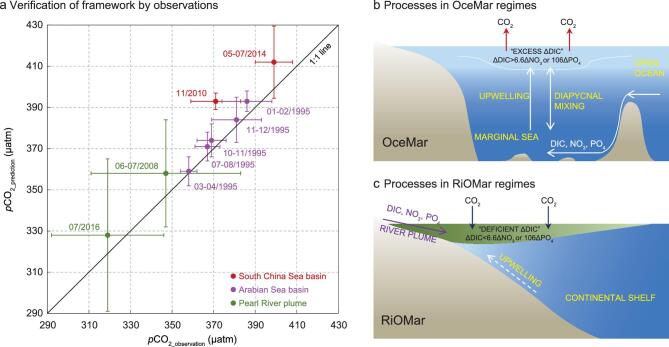Figure 2.
Application of our semi-analytical framework to ocean-dominated margins (OceMars) and a river-dominated ocean margin (RiOMar). (a) Verification of predicted pCO2 using our semi-analytical framework (see the ‘Methods’ section) versus the observed pCO2 in three applications: the South China Sea basin (red, two seasons), Arabian Sea basin (pink, five seasons) and Pearl River plume (green, two seasons). Horizontal and vertical bars represent one standard deviation of pCO2 values, reflecting the spatial variability of field observations and variability of our predictions, respectively. The South China Sea basin and the Arabian Sea basin, both diagnosed as a source of atmospheric CO2 by our framework, are OceMars. In these systems, DIC and nutrients are mainly from processes at the coastal and open ocean interface, whereby the open ocean-originated DIC, NO3 and PO4 are transported upward into the surface mixed layer of the marginal sea through vertical mixing and upwelling, as depicted by (b). By contrast, the Pearl River plume, diagnosed as a sink of atmospheric CO2 by our framework, is a RiOMar. In these systems, DIC, NO3 and PO4 mainly originating from rivers are transported along the plume pathway over the continental shelf, whereas contributions from the subsurface water play a minor role, as depicted by (c). The coupled DIC and nutrient consumption via organic carbon production in the surface mixed layer, or in the plume water, ultimately determine the sea–air CO2 flux of ocean margins. (b) and (c) are revised from [16].

